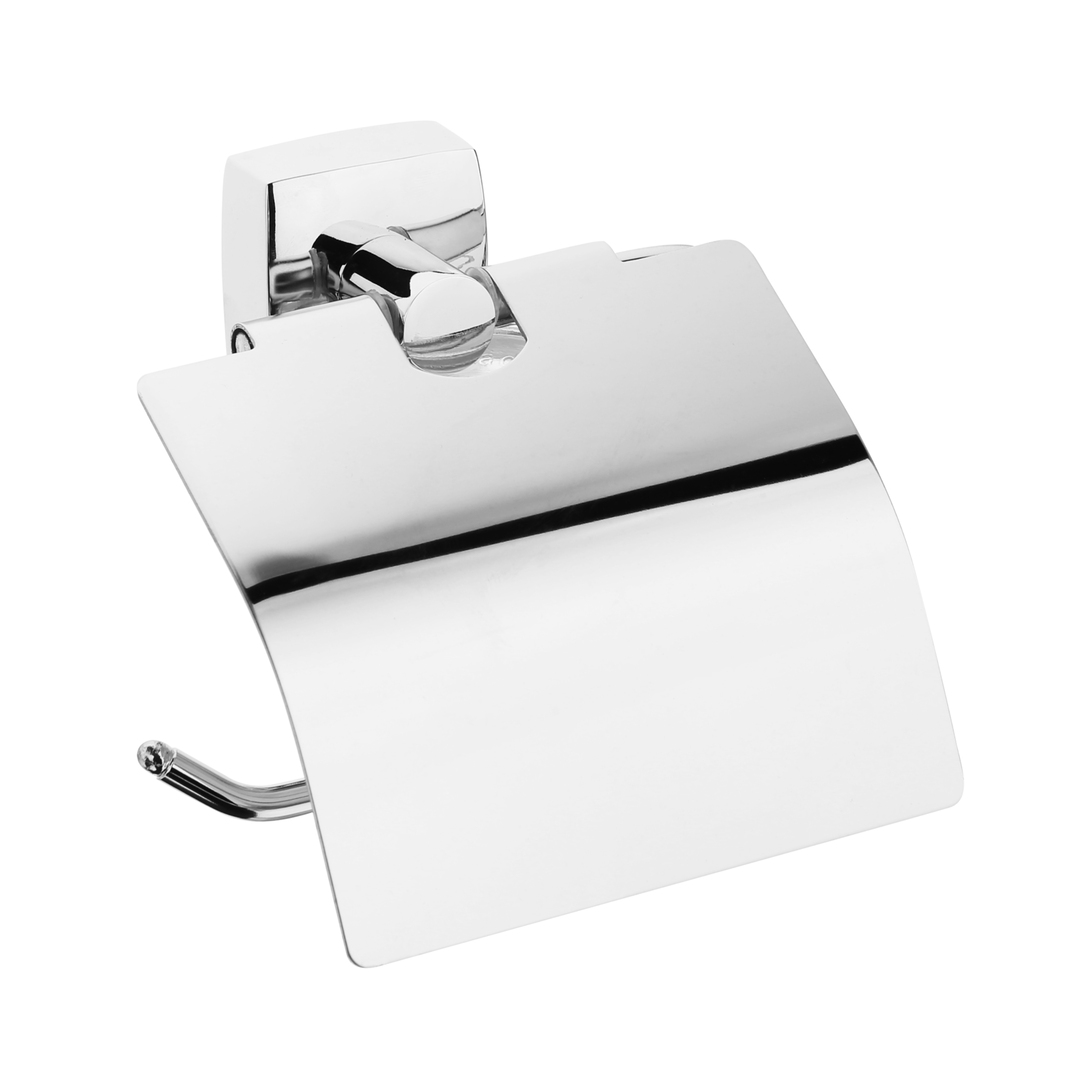Contents:
- How does the sink work?
- Features of the design and mechanism of the drain tank
- Trigger
- How does the location of the tank affect the drain?
- How much water is in the tank?
- Choosing a bowl in the shape of a bowl
- Flushing system in the toilet
- What is a toilet made of?
- What to choose?
Choose a good bathroom equipment for a toilet is not easy because of the abundance of models presented. In order not to make a mistake and understand which toilet is better to wash off, you need to consider what characteristics affect it. One of the main factors is undoubtedly the location and mechanism of the drain tank( armature), but in addition to the quality of the drain the following parameters influence:
- type of the toilet outlet;
- bowl shape;
- availability of the anti-spill system.
To choose a toilet that does its job well, you need to consider its device in detail.
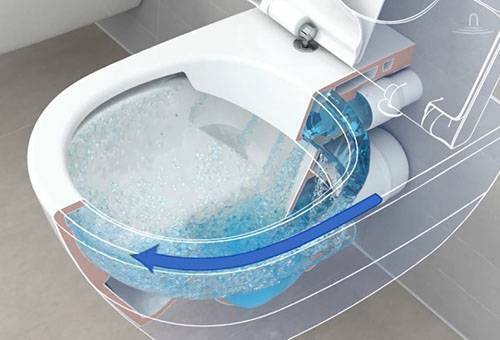
How does the sink work?
The toilet bowl with drain, replacing the pot, was itself a miracle of the technique of those times. Then he was presented with the minimum requirements - to wash away the waste of life. Now the situation is different: the buyer wants to choose a model that does not just wash off, but flushes well, at a time. Modern industry gives such an opportunity, although the design of the draining mechanism for the past 130 years has hardly changed.
By special hose, water enters the drain tank, which is equipped with a shut-off valve system. The filling system allows filling the tank to a certain level, after which the valve closes the water supply. When the button is pressed, the drain valve starts working: the valve opens and water under pressure rushes into the toilet bowl. As the water level has decreased, the filling system again operates. Thus, the alternate operation of the two shut-off valve systems ensures comfortable use of the toilet bowl.

Features of the structure and mechanism of the drain tank
The filling / draining mechanism is located inside the tank, only the control system is displayed. The classical construction is as follows.
- The water inlet hose is attached to the side wall, within 10 cm from the top edge.
- Regulates the filling of the water valve, on the second side of which is a float. It rises with water until the valve closes the filling opening.
- The siphon closes the drain located at the bottom of the tank.
- The control button is connected to the siphon, when it is pressed, the siphon is shifted and the water flow rushes into the bowl of the toilet bowl.
- The overflow protection system is also connected to the siphon.
In modern models, the water inlet hose can be connected from the bottom, near the drain hole. In this case, the check valve is connected to the float by a vertical rod. With this design, the noise level is lower during water recruitment.
Board
The level of water that can be recruited can be adjusted. For this purpose, the adjusting screw is provided on the float.
In the old toilet bowls, the fill and drain valves were operated independently of each other. Modern models of medium and high price segment are equipped with a mechanism with a combined configuration. In it, all elements are interdependent.
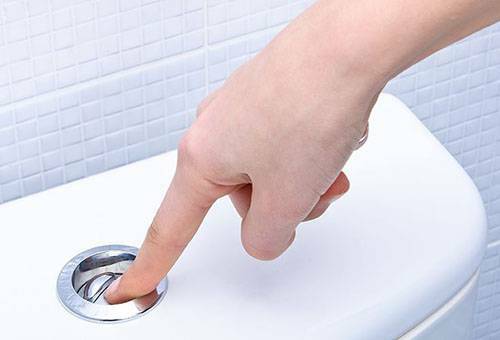
Trigger
The trigger of the drain tank can be of two types - with automatic and mechanical mode. The difference between them is management.
- In automatic mode, it is enough to press the button once, and the specified amount of water is drained into the toilet bowl.
- Mechanical mode provides a water flow only as long as the user presses the button. As soon as the button is released, the drain is blocked.
The tank can be operated by a button located on the top or side, and also by a chain. The chain is always on the side of the tank.
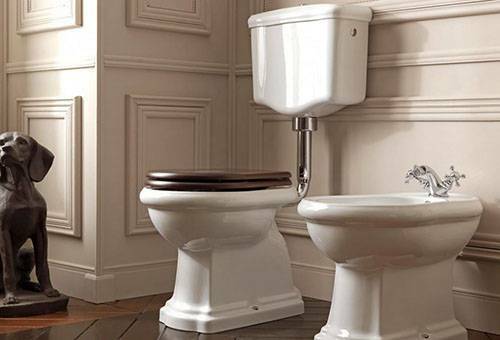
How does the location of the tank affect the sink?
The tanks are also different in the way they are installed. You can choose from these options:
- compact tank fixed on the toilet;
- built into the wall;
- hinged - fastened to the wall slightly above the toilet;
- tank is located high above the toilet( almost under the ceiling), connecting it with a pipe.
The last view - when the tank is attached to the wall much higher than the toilet - provides the largest head of water at the flush, since it is affected by the greatest gravitational force. This arrangement was traditional three decades ago. Now it is chosen if the room is decorated in a retro style. In this arrangement, besides design, there is one more feature: going down under pressure, water "notifies" the entire apartment about this.
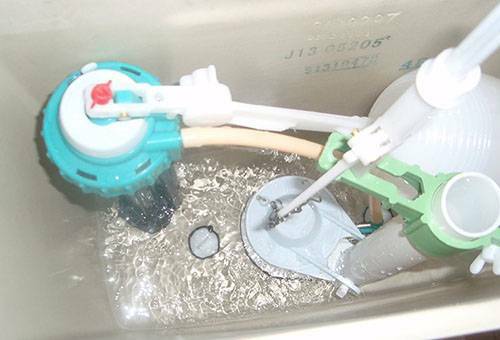
How much water is in the tank?
The tank can accommodate from 6 to 9 liters of water - depending on the model. There are tanks with a system of water saving. They have two discharge modes: 6 liters and half - 3 liters. In such tanks on top there are two control buttons. Regardless of the type of tank, the amount of water to be recycled can be adjusted with a screw on the float.
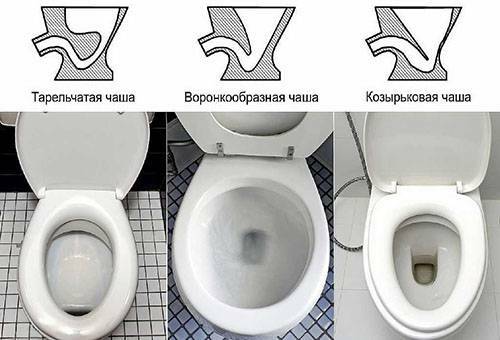
Choosing a toilet bowl in the shape of a bowl
You can choose a toilet bowl by the shape of a bowl from several options:
- with a shelf;
- is funnel-shaped;
- with a slope( visor).
Toilet with a shelf - it's like a tank, located under the ceiling, a retro option. He is the most unhygienic of all kinds of bowls: to wash away the waste of life from the first time with this form is problematic. In addition, this toilet design is characterized by the presence of splashes and splashes during the descent of water.
To be all right, without splashing, it is better to choose a funnel-shaped bowl or bowl with a slope. Both variants will ensure good washability. In this case, you need to pay attention to one more nuance - the function of "anti-splash", ensuring the absence of splashes from getting into the bowl of waste products. It is implemented in many models. This effect is achieved by the location and shape of the drain neck.
In the anti-slip models, the neck is located below, and the drain hole is already there. In addition, the water level in the neck should also be lower. In the technical documentation it is indicated. If it is stated that the toilet bowl with the anti-slip function, then the height of the water in the neck should not be more than 7 cm.
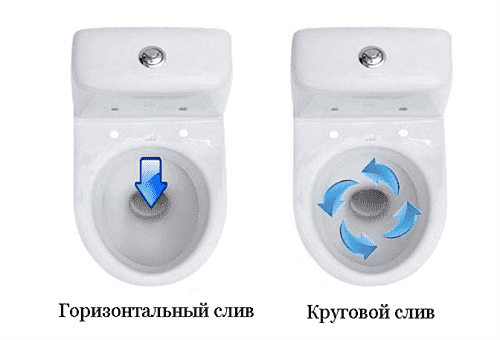
The flush system in the toilet
The efficiency of the flushing depends to a large extent on how the water supply holes are located in the bowl of the toilet bowl. Now there are two varieties - direct and circular( reverse).With direct flushing, water flows down the back of the bowl into the neck. If something is not in the flow path, then it will have to be cleaned with a brush.
With a circular system, water in the toilet will not fall from one, but from three holes located in different places under the rim of the bowl. The flow of water evenly flushes the inner surface of the toilet bowl, forming a funnel in the neck. This design is considered the most hygienic and practical.
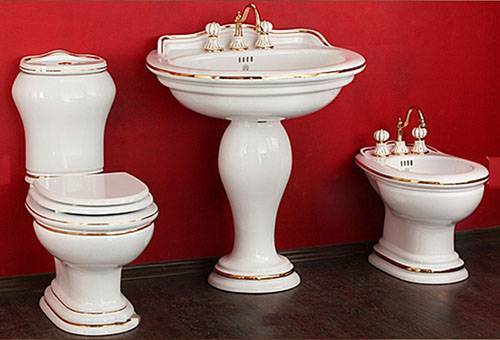
What is a toilet made of?
The most common material for the bowl of the toilet bowl is ceramics( faience) and porcelain. Ceramics are porous material. To ensure that the surface does not absorb water, the ceramic toilet bowls are covered with glaze. Porcelain is also more resistant to the effects of not only water, but also chemicals. Unfortunately, these qualities are leveled by the high cost of porcelain toilet bowls, so ceramic models are presented in the low and middle price segment.
Until glaze - the top layer of the ceramic - is not damaged, then it does not have any effect on the flushing. If you use it for cleaning with metal brushes and aggressive chemicals, glaze is easily damaged. In this case, the surface will become rough and the waste will be retained, not completely washed away.
Now on the market you can find plastic toilets covered with a layer of fiberglass, and also models from stainless steel. They did not get a big spread, so it's still difficult to say about their practical properties.
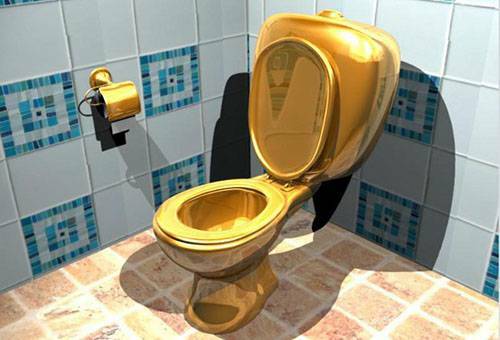
What to choose?
To choose the plumbing in the toilet with the appropriate characteristics, you need, first of all, to determine what is most important for the owners of the apartment. For example, if the main parameter is a good flush, and the noise is not a hindrance, the retro-style tank will be the best option. If, on the contrary, noiselessness is one of the important characteristics, it is worth giving preference to the tank, in which the water is recruited from below. In order to wash it well, you need to choose a bowl with a circular flush.
Water saving in the first place? Then you should buy a toilet with a "dual-mode" drain tank. In this article various variants of toilet bowl and tank designs are considered. We hope that all of the above will help to choose the model that is most suitable for all characteristics.
We advise you to read the article: how to choose a floor dryer

